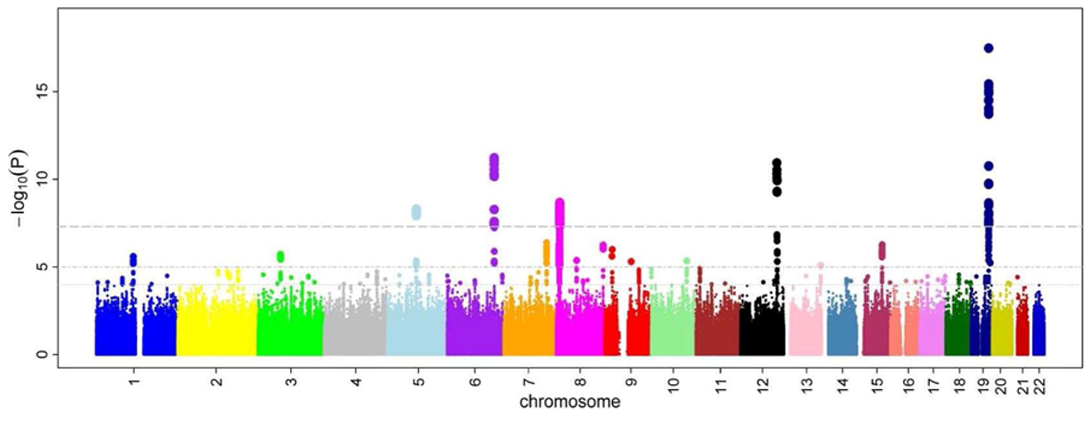Genome Wide Association Studies: the Panacea for Human Disease
Within the past decade, a multitude of innovations have contributed to major discoveries within the medical field; yet, genome wide association studies (GWAS) have notably revolutionized diagnostics in addition to providing patients with a personalized approach for treatment options. In truth, the entirety of the human genome can be attributed to a code; a complex mechanism that experts have been trying to understand for years. However, upon the completion of “the Human Genome Project in 2003 and the International HapMap project in 2005” (NHGRI 2015), researchers are now able to recognize the exact location of mutations in human DNA by analyzing specific sections referred to as single nucleotide polymorphisms (SNPS). With the recent utilization of genome wide association studies, researchers have validated that the genesis of common disease occurs within SNPS. These markers signify genetic variants that occur frequently in the human population. Genome-wide association studies leave researchers with great amounts of summary and statistical data that provide a deeper look into the extent of whether or not genetic make up effects one’s chances of developing a certain disease (Holland D et al 2016). Ultimately, GWAS allows us to identify genotypic abnormalities in order to treat “phenotypic variation” (Ju et al. 2009).
For example, various genome wide association studies have been conducted on Type I diabetes; a disease that plagues “more than 300,000 canadians” (JDRF 2009). In 2009, Sergey Nejentsev and fellow researchers published their study “Rare Variants of IFIH1, a Gene Implicated in Antiviral Responses, Protect Against Type 1 Diabetes”. This specific genome wide association study discovered a region that, when a single base is varied, codes for diverse amino acids. Interestingly enough, “rare individuals carrying valine at position 923 of the IFIH1 protein have only ∼50% risk of developing [type I Diabetes] compared with those who carry isoleucine” (Nejentsev et al. 2009).
To conduct a GWAS, one must compare two sets of DNA: a population diagnosed with the disease, and a control population. Prior to commencing the study, experts must determine “candidate genes” (Nejentsev et al. 2009) to map, due to the fact that testing the entire human genome would take a copious of amount of time in addition to materials. When all the data has been collected, researchers utilize statistical analysis to distinguish any differences in allele frequencies between the two sample genomes. If a particular genetic variation appears more frequently in someone with the disease than someone without, the said variation is considered to be “associated” with that disease. In 2013, there were close to 8,000 SNPs identified through over 1,400 GWAS to be related to a variety of complex human disease (Pei Y et al 2014). The current cost to do any of these comparison studies and even simply the scanning for one’s genetic code are currently quite high. In the future however it will most likely become a lot more affordable with increase in demand.
In addition to identifying the SNPs that are directly correlated to common diseases, GWAS have introduced a new sub discipline of treatment referred to as personalized medicine. Based on the results from a particular study, doctors can predict “both the disease risk among healthy individuals in the general population and the therapeutic response among patients” (Katsios et al. 2010). Furthermore, with the improvement of modern technology in the future to come, GWAS impact can become even more extensive by enabling health care professionals to be able to provide people with information about their risks of individually developing certain diseases as well as with heritability risks for future generations (NHGRI 2015). Also, GWAS have also been used to find the risk factors for individuals for many different diseases such as: Alzheimer’s, Crohn’s disease, prostate cancer, and mental health diseases. To conclude, GWAS have produced profound discoveries that ultimately contribute to the global wide fight against common disease.
References
Gu J, Liu y, Kryitsis A, Bondy M. 2009. Molecular Epidemiology of Primary Brain Tumors. ScienceDirect. [Internet]. [cited 2016 March 1]; 6(3):427-435. Available from:
http://www.sciencedirect.com/science/article/pii/S1933721309000981 doi: 10.1016/j.nurt.2009.05.001
Holland D, Wang Y, Thompson WK, Schork A, Chi-Hua C, Min-Tzu L, Witoelar A, Werge T, O’Donovan M, Andreassen, OA, et al (2016). Estimating Effect Sizes and Expected Replication Probabilities from GWAS Summary Statistics. Frontiers in Genetics [Internet]. [cited 2016 Mar 7]; 15(7); 1-11. Available from: http://eds.b.ebscohost.com.ezproxy.tru.ca/eds/pdfviewer/pdfviewer?sid=3793b945-643f-4bfe-872b-e43216f53a15%40sessionmgr102&vid=11&hid=117
doi: 10.3389/fgene.2016.00015
[JDRF]. Juvenile Diabetes Research Foundation. [Internet]. 2009. Toronto (ON). [updated 2009 Dec; cited 2016 Mar 2] Available from: http://www.jdrf.ca/news-and-media/fact-sheets/type-1-diabetes/
Katsios C and Roukos D. 2010. Individual genomes and personalized medicine: life diversity and complexity. Future Medicine Ltd. [Internet]. [cited 2016 March 3]; 7(4):347-350. Available from: www.futuremedicine.com/doi/abs/10.2217/pme.10.30 doi: 10.2217/pme.10.30
Nejentsev S, Walker N, Riches D, Egholm M, Todd J. 2009. Rare Variants of IFIH1, a Gene Implicated in Antiviral Responses, Protect Against Type 1 Diabetes. Science. [Internet]. [cited 2016 March 3]; 3254(5925):387-389. Available from: http://science.sciencemag.org/content/324/5925/387.full doi: 10.1126/science.1167728
[NHGRI] National Human Genome Research Institute. [Internet]. 2015. Bethesda, (MD): National Institutes of Health. [updated 2015 Aug 22; cited 2016 Feb 14] Available from: https://www.genome.gov/20019523
Pei Y, Zhang L, Papasian, C J, Wang Y, & Deng H (2014). On individual genome-wide association studies and their meta-analysis. Human Genetics,[Internet] [cited 2016 Feb 09] 133(3), 265-279. Avaliable from: http://ezproxy.tru.ca/login?url=http://search.ebscohost.com/login.aspx?direct=true&db=mnh&AN=24114349&site=eds-live
doi:10.1007/s00439-013-1366-4
